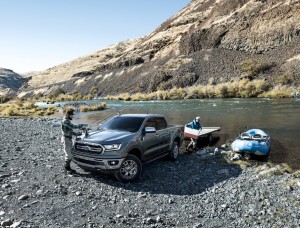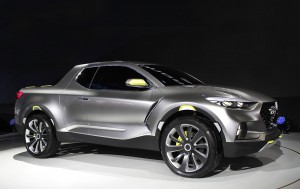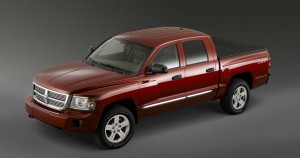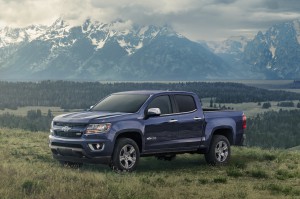Once written off for dead – or at least dying – the midsize pickup market is coming back with a bang, but not only are sales on the rise, but also is the number of players entering, or returning, to the segment.
The question facing the industry is whether the list of brands might be growing too fast and too large, something that could make it hard for anyone to turn a profit.
Among the latest to target the U.S. midsize market are Ford and Jeep, both returning after lengthy absences. But Volkswagen could be eyeing its opportunities, as well as Mahindra & Mahindra, the Indian automaker that recently begun building off-road vehicles at a small plant in the Detroit suburbs. And Hyundai is moving forward with the development of a car-based compact pickup based on the Santa Cruz concept of a few years back.
On Tuesday, VW pulled the wraps off the Tarok, a small pickup it will initially offer in Brazil. But the automaker noted in a statement that the truck “has the potential to boost Volkswagen’s model range in other global markets.”
(Ford sees big growth opportunities for new Ranger pickup. Click Here for the story.)
The German automaker didn’t say what those “other” markets might be, but it has been trying to build up its light truck line-up in the U.S. and some observers believe a pickup could be something it is considering, along with new SUVs like the three-row Atlas.
If not the Tarok, VW could look at other ways to get a truck into the States. The carmaker signed a memorandum of understanding with Ford earlier this year, the initial goal focused on light commercial vehicles. But, in recent weeks, the two carmakers have confirmed they are exploring other potential tie-ups that are believed to include areas as diverse as electric and autonomous vehicles, as well as pickups.
In an interview with Automotive News, VW Group CEO Herbert Diess recently said his company might gain access to some of the technology that is used in the midsize Ford Ranger.
Ford was once a dominant player in that segment but, as midsize sales collapsed in the ‘90s and aughts, it killed off the U.S. Ranger, shutting down its factory near Minneapolis in 2012. A new, global version of the truck was introduced, but until a few years ago, Ford planners felt there wasn’t a profitable market in the States. That attitude changed once General Motors revived two of its own midsize models, the Chevrolet Colorado and GMC Canyon, which have kicked life back into the midsize market.
Late last month, Ford began rolling out a new, American Ranger – based on a heavily modified version of the overseas truck – at its Wayne, Michigan assembly plant. (The same factory will see the rebirth of the old Ford Bronco SUV about a year from now.)
“We’re very excited with the growth we’re seeing in the midsize pickup segment,”said Joe Hinrichs, Ford’s president of the Americas, during an event marking the relaunch of Ranger production.
Last year, sales rose to 452,336, from 448,398 in 2016, a 0.9% increase contrasting the overall decline of the American new vehicle market. Hinrichs told reporters Monday he expects the midsize market will quickly reach 500,000, with “plenty of room for everybody.”
Whether there will be enough growth to provide room for all is uncertain, though the industry axiom is that nothing spurs growth like new product. And plenty of product there will be.
(Click Here for more about the range of Ford and VW’s discussions.)
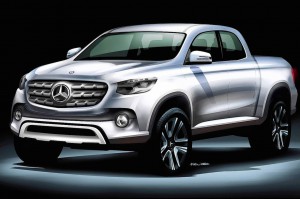
Mercedes-Benz released this drawing in discussing its plans to get into the luxury pickup truck segment.
Along with the reborn Ranger, Jeep will return to the segment after a decades-long absence. Its new Scrambler model is set to make its formal debut at the Los Angeles Auto Show later this month. It hasn’t offered a pickup since the demise of the old Commanche in 1992.
The Scrambler project was spearheaded by Mike Manley, the long-time Jeep boss who was suddenly elevated to CEO of Fiat Chrysler Automobiles in July following the unexpected death of Sergio Marchionne.
At a corporate strategy session little more than a month before, Marchionne also hinted that Dodge could get back into the fray, something that FCA effectively confirmed in September. The question is whether its midsize model will bring back the Dakota nameplate and, if it does, will it be marketed through Dodge or, like the full-size 1500 line, be sold as a Ram.
And it might not be the last new model targeting the segment. Hyundai is expected to come in with a production version of its wildly popular Santa Cruz concept truck by around 2020.
And then there’s Mahindra & Mahindra. A decade ago, the Indian automaker attempted to launch a U.S. dealer network, an effort that collapsed during the Great Recession. It recently launched production of a small off-road vehicle, the Roxor, at a plant in Auburn Hills, Michigan. And more is likely coming Group Chairman Anand Mahindra told reporters at the opening of the factory a year ago.
“I think a very logical step after that would be to get on-road,” he hinted. While a street-legal Roxor appears to be in the works, a version of one of Mahindra’s Indian pickups could also follow.
Even Mercedes-Benz might get in the picture. The company recently launched its X-Class pickup in a number of markets. And while there currently are no U.S. plans, Dieter Zetsche, CEO of Mercedes’ parent Daimler AG has suggested the time “may be ripe” for it to get into the American truck game.
Even if some of these potential products fail to materialize, the midsize pickup segment will become one very crowded place. That could pose a serious challenge to existing players, starting with Toyota whose Tacoma still dominates sales, as well as Nissan, whose Frontier model is the low-cost entry point into the segment. Then there’s General Motors, which many credit with kick-starting the segment with the revival of its Chevrolet Colorado and GMC Canyon models. Honda, meanwhile, has a unique position in the segment, its Ridgeline model the only one based on a crossover, rather than truck-based, platform.
(For more about Hyundai’s truck plans, Click Here.)
The return of the Ranger and Scrambler models should give a clear indication of whether there’s enough of a market to continue to absorb all the players looking to enter the midsize pickup segment.

